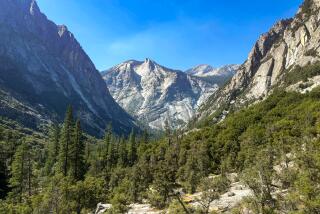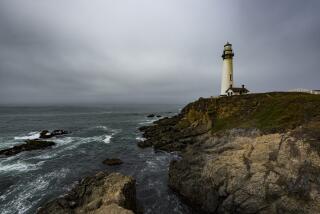Attractions Vary Along Blue Ridge Parkway
- Share via
ASHEVILLE, N.C. — Spanning 469 miles, the Blue Ridge Parkway runs like a backbone along the Appalachian Mountains.
Crossing three states, connecting six mountain ranges and providing employment for thousands, this scenic national parkway is operated by the National Parks Service.
Each year the parkway is traveled by more than 19 million visitors. By the end of this year, the road is expected to have seen more than 400 million visitors in its 51 years of existence.
Why is it so popular? The roads are toll-free, various forms of inexpensive accommodations are available and no billboards mar the scenery.
The Appalachian Mountain culture has been preserved in the museums, craft displays and farms along the parkway. Hundreds of summer festivals take place in towns along the road.
Hiking, Fishing, Flowers
Eighteen recreation areas offer hiking, fishing and other nature-oriented activities. Along the parkway are more varieties of wildflowers than grow in all of Europe, and it goes through the largest deciduous forest in the world.
The list could go on and on.
Only 55 years ago, the parkway was an idea being tossed around by the Roosevelt Administration. In the midst of the Great Depression, President Franklin D. Roosevelt was hard pressed to find a project for Appalachia that was constructive and in the national interest. A new national parkway, which would employ locals and bring in tourist dollars, seemed to answer both needs.
Today the attractions on and off the parkway vary greatly--from the splendid view from the Peaks of Otter in Virginia to the manicured gardens of the Biltmore Mansion in North Carolina.
The only things that remain the same all along the parkway are the regulations: speed limit 45 m.p.h., no littering, no open fires.
A Leisurely Trip
Driving at this leisurely pace, it would take about a week to go from one end to the other. About every 20 miles there is some sort of visitor center with food, gasoline, hiking trails and nature talks by rangers. Nine campgrounds and five lodges are right along the parkway.
The parkway’s northern entrance is at Shenandoah National Park at Front Royal, Va. This park has by far the best tourist facilities on the Virginia side of the parkway, and could consume three or four days of touring.
Park headquarters are in Skyland, at an altitude of 3,680 feet and overlooking a fertile, rolling valley. Several types of accommodations are available, generally running $20 per person. The main lodge also houses a restaurant, tourist shop and bar. Motel-type rooms have all facilities except TV. Self-contained cottages have showers, kitchens and bunk beds. There are campgrounds, playgrounds, conference centers and service shelters.
Despite all this, the park service has managed to preserve the area’s natural beauty. People come from all over the nation to hike the trails at Shenandoah Park. Monstrous waterfalls, long rocky ravines, pine forests and extensive caverns are all part of the park.
Restored Cabin
South of Shenandoah, at milepost 30, is the Humpback Rocks information center. A cabin has been restored and includes a springhouse, root cellar and pigpen, plus a museum where workers show visitors the old Appalachian ways of making ceramics and quilts and prese1920362862Appalachian Trail runs to the top of Humpback Mountain.
South again, at milepost 86, is Peaks of Otter Lodge. Below the Peaks of Otter, the lodge is beside a small lake. Open all year, it is one of four lodges along the parkway.
In nearby Staunton is the house where Woodrow Wilson was born. The University of Virginia, along with the house that one of its distinguished alums--Thomas Jefferson--built, is in Charlottesville. The house is highly recommended. There is Natural Bridge, though with its video arcade and indoor swimming pool it seems anything but natural.
The lovely town of Lexington has changed little since the days when it produced the two generals of the Confederacy, Stonewall Jackson and Robert E. Lee. One of the few towns in Virginia that has made a conscious effort to hold on to the architecture of the last century, it is worth visiting. Each summer, Lexington hosts a series of nightly outdoor dramas.
The cabins at Rocky Knob have been renovated from their days as quarters for workers from the Civilian Conservation Corps. They are self-contained, with kitchen, bathroom and shower facilities.
Old-Time Operations
At Mabry Mill, near the border of Virginia and North Carolina, is a one-man blacksmith and milling operation. The water-powered gristmill still churns out coarse flour, which is used in the nearby restaurant for buckwheat pancakes, cornmeal cakes and fried grits. This is one of the most frequently visited areas on the parkway.
Whereas Virginia relies mainly on its historic and natural attractions to bring in tourists, North Carolina has built a strong tourist industry.
The Great Smoky Mountains are taller and more scenic than the Blue Ridge, and the summer temperatures are cooler. The Carolina side also has more man-made attractions.
Half a mile from the North Carolina state line is the Cumberland Knob visitor center, on the first stretch of parkway, built in 1935. A few miles from the visitor center is Doughton Park, a 6,000-acre facility with campground, outdoor plays in the summer, service station, hiking trails and Bluffs Lodge.
Smaller and older than the lodge at the Peaks of Otter, this lodge charges about the same, $35.
Crafts Demonstrations
Moses H. Cone Memorial Park at milepost 294 is home to the Parkway Craft Center. The house, once owned by a textile baron, belongs to the park service. More than 200 craftsmen display their wares at the house, and demonstrations of various crafts are frequent throughout the summer.
Also nearby are the towns of Blowing Rock and Boone. Though a favorite destination for summer visitors, Blowing Rock has maintained its old-fashioned storefront image. The road to Boone has family-oriented attractions including Mystery Hill, the Tweetsie Railroad and Magic Waters family park.
Just beyond milepost 298, the parkway is interrupted. This section, called the “missing link,” is expected to open this year, but before then, early visitors may have to take a 7.5-mile detour. The parkway resumes at Linn Cove viaduct, and a walk along the viaduct reveals a beautiful view of the surrounding mountains.
At Linville Falls, a visitor center recently opened. The area is outstanding for its trails and flora. Four trails run from the visitor center in opposite directions and give way to views of the nearby gorge, which is surrounded by virgin timber, rhododendron, galax, azalea and mountain laurel. It is one of the most enchanting spots on the parkway.
Highest Peak in Area
Past milepost 355 is Mt. Mitchell State Park, a 1,224-acre park at the top of the Black Mountains. It is accessible only from the parkway and its major attraction is the 6,684-foot Mt. Mitchell, the highest peak in the eastern United States. The park has a visitor center as well as tent sites for those who wish to climb to the top.
About 30 miles south of Mt. Mitchell is one of the greatest attractions of the parkway, the Folk Art Center. It has been operating for six years, and drew more than 300,000 visitors last year. Its collection of Appalachian handcrafts is the most complete in the Appalachian region.
Mt. Pisgah, milepost 407, also has a lodge for overnight stay. From this point on, the views become even more breathtaking as the road runs south. Eventually, as the Great Smoky Mountains come into sight, there will be a choice.
Either continue to the Oconaulftee Indian village near the end of the parkway at Cherokee, or turn off to Balsam Mountain Campground on the edge of Great Smoky Mountains National Park. The Indian village (reputed to be the wealthiest in the country) has a museum, an 18th-Century village and a nightly outdoor drama.
The Great Smokies, on the other hand, may be the most beautiful mountains east of the Mississippi. And in summer they are also the most temperate. It is not uncommon for the temperatures to be in the high 60s while the rest of the South is sweltering in the 90s.
Where to Write
For more information about the parkway: The Blue Ridge Parkway Assn., P.O. Box 475, Asheville, N.C. 28802. This association cannot make reservations.
You must write to each lodge for current prices and rules:
The Peaks of Otter Lodge--62 rooms, $42 single, $54 double, no TV or phones in rooms; P.O. Box 489, Bedford, Va. 24523. Rocky Knob Cabins--six housekeeping units, $28 a night, no TV, phones or bathrooms in units; Meadows of Dan, Va. 24120. Bluff’s Lodge--24 rooms, $36.50 single, $45.50 double, no TV in rooms; Laurel Springs, N.C. 28644. The Pisgah Inn--50 rooms, $40 single, $50 double, no phones in rooms; Parkway Inn Inc., P.O. Drawer 749, Waynesville, N.C. 28786. Rates subject to change.
For more information and assistance in trip planning, write to: Information Clerk, Blue Ridge Parkway, 70 Northwestern Plaza, Asheville, N.C. 28801; phone (704) 259-0779.
More to Read
Sign up for The Wild
We’ll help you find the best places to hike, bike and run, as well as the perfect silent spots for meditation and yoga.
You may occasionally receive promotional content from the Los Angeles Times.






